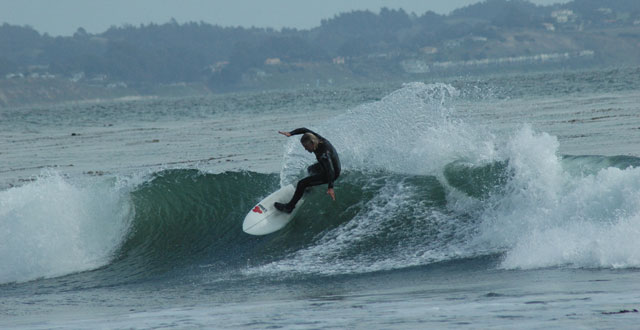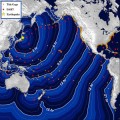The weather in Silicon Valley may be hot and dry all summer, but just over the hill, great waves beckon to those who have always dreamed of surfing in Santa Cruz.
As people come to Silicon Valley from all over the country and globe, many who have never surfed are heading to Santa Cruz to try out the quintessential California pastime. All along the coast, surfers line up their boards just off the shore, patiently waiting for the perfect wave to take them for a ride. To the casual observer it can look glorious, but also daunting.
We spoke with Barry Green, a Bay Area native and founder of Making the Drop surf school in Santa Cruz about what a beginner can expect on their first day out and the benefits of surfing. Green has been surfing for 30 years and coaching surfing since 1998.
What do you think draws people to surfing?
Surfing has always been cool, but with the modern “work hard, play hard” culture, the floodgates have definitely opened for people to explore more recreational activities.
The tech industry is drawing people from all over, many of whom have never tried surfing before. They’re near Santa Cruz, which has consistent, high-quality waves, so why not try it? People want adventures, to make lasting memories, feel good and live fully and meaningfully. Surfing provides that experience.
What are the advantages of starting out with an instructor or surf school?
Trying to catch waves amid a crowd of people is overwhelming and even scary. It’s like learning to drive stick-shift in rush hour traffic—there are so many things to focus on at the same time.
An instructor will help you integrate safely with the general surfing public and get the most out of your time in the water. In the early stages you are so focused on what you are doing, you aren’t looking around at other people coming in on the waves—that’s the coach’s job.
ALSO SEE: Top 10 San Jose Day Trips
What is a typical first lesson like? Can most people expect to be able to stand up and ride a wave on their first day?
Its starts with some discussion on the beach covering board-body positioning, how to paddle, stand-up transition technique and what the dynamics are like with other surfers.
You can spend a lot of time throwing information at a new surfer, but I just like to give them the basics. I’ll distill things down to what they can handle. Then we get in the water, and put things into practice.
It starts with that interaction with the wave, and feeling the energy as you paddle out. Some people are un-phased and for some people, a one-foot wave is their Mavericks, and I have to respect that.
The ocean is a live thing, and it brings up a lot of different responses. My background in teaching and counseling allows me to see what each person needs. Most people are able to stand and ride a wave their first time. Everyone is on their own path of progression, so all that matters is getting out there.
What do you think the benefits of surfing are, particularly for the casual surfer who can’t get out every day?
Being in or near water is something that greatly enhances our well being. A lot of my clients are people who are looking for ongoing training, and for them, I’m like a golf or a tennis pro, helping them improve, or possibly train for competition.
I’m also part therapist. Whether clients are with me for years, or just want to try surfing once, surfing is a kind of moving meditation. People can step into the water and let go and unplug. You have to pay attention in the moment—you can’t think about a million things. You’re out of your head, and in your body.
In surfing, you’re going to get overrun, caught and tumbled. That’s going to happen. The question is how you’re going to respond. Lessons learned surfing can translate into work, into how you deal with intense pressure from a deadline and emotion from coworkers. It’s a way to learn to just dive under whatever is coming at you, like a wave, and be calm while it tumbles you.
Do you need to be a strong swimmer to learn to surf?
I’ve had clients who are extremely strong swimmers and they can paddle all day, but they still need to work on technique and timing of catching waves and getting up. It helps [to be a strong swimmer], but it isn’t necessary, and strengthening your body for the paddling part is something that you can focus on during the week, with swimming and weight training.
How long does it take to get good?
The learning curve in surfing is very long. You can enjoy surfing at any level, but I’d say you need to go once a week, minimum, to progress consistently. Accumulating 100 hours of water time in a year is a good threshold for becoming a novice surfer. Surfing is ultimately a lifestyle, and the journey is quite an enjoyable one at any level.
Surfers have a reputation for not liking outsiders crowding their waves. Do newcomers to the sport need to be aware of this?
In my 30 years of surfing, the culture has definitely changed a lot. I grew up in the valley and came over here in the early 80s, and I was very aware of the pecking order.
Now, intimidation of outsiders is no longer as prevalent. Still, you definitely have to strive to be respectful. When the waves are good, you will have more experienced surfers in the water, and as a result more expectation for good etiquette. With a wide range of skill level and experience out there, people do end up running into each other. If you start from a mindset of, “how are my actions-decisions impacting others?” you will usually do fine.
What about sharks?
(Laughs) Sharks are not something to be overly worried about. Just to keep things in perspective, humans kill over 100 million sharks per year. There are great whites in the bay, but I haven’t seen them in the areas where I teach.
The more that people are recreating in wild environments, the more they’re going to come up against nature. You’re vulnerable as a human being, accepting that and moving forward is something that surfers have to work on.







 Travel: Holman Ranch in Carmel Valley Caters to Work Retreats
Travel: Holman Ranch in Carmel Valley Caters to Work Retreats  San Jose's Fahrenheit Restaurant and Lounge to Close
San Jose's Fahrenheit Restaurant and Lounge to Close 


